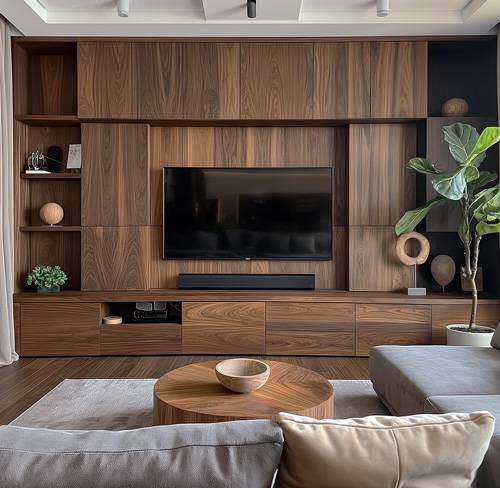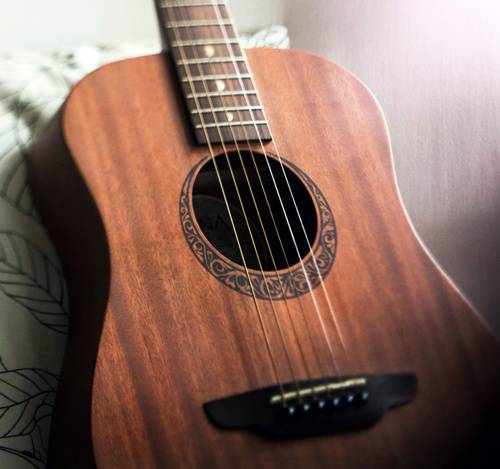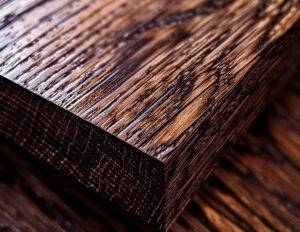Rosewood
Rosewood, a symbol of style and class, is mainly used in instrument making and for artistic inlay work. Depending on the location of the tree, its colour palette ranges from pink-red to dark brown.
Various types of wood from the Dalbergia genus, which grow in the tropical and subtropical regions of Asia, are obtained under the trade name rosewood. The dense and durable East Indian rosewood is particularly hard and tough, with a characteristic brown-violet heartwood and darker stripes. It exudes a pleasant rose fragrance and is well suited for woodturning.
Rosewood is often used for small objects where hardness and workability are crucial. As a veneer, it is popular in interior design and in the manufacture of high-quality chess pieces.

An overview of rosewood:
- Rosewood is a noble choice for interior design.
- Rosewood is robust and durable.
- Rosewood has a unique look thanks to its natural grain.
- Rosewood has a positive effect on humidity and ensures a healthy indoor climate.
- Rosewood is versatile and has ecological advantages compared to other materials.
Rosewood – a noble choice for interior design
Rosewood is known for its noble and high-quality appearance. It has a natural beauty that enhances any room. The dark brown tones of the wood add a touch of elegance and luxury to any piece of furniture. So it’s no wonder that rosewood is a favourite with designers and architects.
Robust and durable: the properties of rosewood
Another major advantage of rosewood is its robustness and durability. The wood is extremely hard and resistant to scratches, knocks and other everyday damage. Compared to other materials such as plastic or MDF boards, rosewood lasts significantly longer.
Unique look: the natural grain of rosewood
The natural grain of rosewood makes each piece unique and particularly attractive for interior design. The grain varies from piece to piece and gives the wood an individual flavour. Its colouring ranges from a warm dark brown to reddish or purple tones, making rosewood a real eye-catcher.

Healthy indoor climate: the positive effects of rosewood on air humidity
Rosewood also has a positive effect on the indoor climate. It regulates humidity naturally by absorbing moisture from the air and releasing it again when required. This is particularly beneficial in rooms with high humidity, such as bathrooms or kitchens, as it prevents mould growth and creates a healthy indoor climate.
Versatile: the possible uses of rosewood in interior design
Rosewood can be used in many ways in interior design. It is ideal for furniture such as tables, chairs or beds, but also for flooring, wall panelling or stair treads. Thanks to its elegant appearance, it goes well with both modern and classic designs and can be combined well with other materials.
Sustainability and environmental awareness: The ecological advantages of rosewood compared to other materials
Another important aspect of using rosewood is its sustainability and environmental awareness. Rosewood is a natural raw material that comes from sustainably managed forests. It grows back quickly and can therefore be used in the long term without harming the environment. Compared to other materials such as plastic or metal, rosewood is an environmentally friendly choice.

Conclusion
To summarise, rosewood is an excellent choice for interior design. It offers numerous advantages such as its elegant appearance, robustness and durability as well as positive effects on the indoor climate. It is also versatile and ecologically sustainable. So if you are looking for a high-quality building material, you should definitely consider rosewood.
FAQs
What is rosewood?
Rosewood is a hardwood obtained from various species of Dalbergia trees. It is known for its hardness, density and beautiful grain.
What are the advantages of rosewood for interior design?
Rosewood is very resistant to wear, scratches and moisture. It is also very durable and can last for decades or even centuries. In addition, it has a natural beauty and grain that makes it a popular material for furniture and flooring.
How is rosewood used in interior design?
Rosewood is often used for furniture, flooring, wall panelling and stairs. It can also be used for doors, window frames and other architectural elements.
How do I care for rosewood in interior design?
Rosewood should be cleaned and cared for regularly to maintain its beauty and durability. It should not be cleaned with harsh detergents or abrasive cleaners, but with a damp cloth or mild detergent. It is also important to protect it from moisture and direct sunlight.





